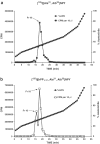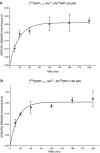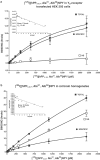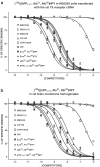Development and characterization of a highly selective neuropeptide Y Y5 receptor agonist radioligand: [125I][hPP1-17, Ala31, Aib32]NPY
- PMID: 12890716
- PMCID: PMC1573964
- DOI: 10.1038/sj.bjp.0705376
Development and characterization of a highly selective neuropeptide Y Y5 receptor agonist radioligand: [125I][hPP1-17, Ala31, Aib32]NPY
Abstract
(1) The existence of multiple classes of neuropeptide Y (NPY) receptors (Y(1), Y(2), Y(4), Y(5) and y(6)) is now well established. However, one of the major difficulties in the study of these various receptor subtypes is the current lack of highly selective probes to investigate a single receptor class. Up to most recently, this was particularly true for the Y(4) and Y(5) subtypes. (2) [hPP(1-17), Ala(31), Aib(32)]NPY, the first highly selective Y(5) agonist, was iodinated using the chloramine T method and purified by high-pressure liquid chromatography. (3) Binding performed in rat brain homogenates revealed that equilibrium was reached after 120 min (t(1/2)=21 min) and 60 min (t(1/2)=12 min) at 25 and 100 pM [(125)I][hPP(1-17), Ala(31), Aib(32)]NPY, respectively. (4) Isotherm saturation binding experiments demonstrated that [(125)I][hPP(1-17), Ala(31), Aib(32)]NPY binds to an apparent single population with high-affinity (K(D) of 1.2 and 1.7 nM) and low-capacity (B(max) of 14+/-3 fmol/100,000 cells and 20+/-5 fmol/mg protein) sites in Y(5) receptor HEK293-transfected cells and rat brain membrane homogenates, respectively. No specific [(125)I][hPP(1-17), Ala(31), Aib(32)]NPY binding sites could be detected in Y(1), Y(2) or Y(4) receptors transfected HEK293 cells, demonstrating the high selectivity of this ligand for the Y(5) subtype. (5) Competition binding experiments performed in rat brain membrane homogenates and Y(5)-receptor transfected HEK293 cells demonstrated that specific [(125)I][hPP(1-17), Ala(31), Aib(32)]NPY binding was competed with high affinity by Y(5) agonists and antagonists such as [Ala(31), Aib(32)]NPY, [hPP(1-17), Ala(31), Aib(32)]NPY, hPP, CGP71683A and JCF109, but not by Y(1) (BIBP3226), Y(2) (BIIE0246) and Y(1)/Y(4) (GR231118) preferential ligands. (6) Taken together, these data demonstrate that [(125)I][hPP(1-17), Ala(31), Aib(32)]NPY is the first highly selective Y(5) radioligand to be developed. This new probe should prove most useful for further detailed studies of the molecular and pharmacological properties of this receptor subtype in brain and peripheral tissues.
Figures





References
-
- BITRAN M., DANIELS A.J., BORIC M.P. GW1229, a novel neuropeptide Y Y1 receptor antagonist, inhibits the vasoconstrictor effect on neuropeptide Y in the hamster microcirculation. Eur. J. Pharmacol. 1997;319:43–47. - PubMed
-
- BRADFORD M.M. A rapid and sensitive method for the quantitation of microgram quantities of protein utilizing the principle of protein–dye binding. Anal. Biochem. 1976;72:248–254. - PubMed
-
- CABRELE C., BECK-SICKINGER A.G. Molecular characterization of the ligand–receptor interaction of the neuropeptide Y family. J. Pept. Sci. 2000;6:97–122. - PubMed
-
- CABRELE C., LANGER M., BADER R., WIELAND H.A., DOODS H.N., ZERBE O., BECK-SICKINGER A.G. The first selective agonist for the neuropeptide Y Y5 receptor increases food intake in rats. J. Biol. Chem. 2000;275:36043–36048. - PubMed
-
- CABRELE C., WIELAND H.A., KOGLIN N., STIDSEN C., BECK-SICKINGER A.G. Ala(31)–Aib(32): identification of the key motif for high affinity and selectivity of neuropeptide Y at the Y5-receptor. Biochemistry. 2002;41:8043–8049. - PubMed
Publication types
MeSH terms
Substances
LinkOut - more resources
Full Text Sources
Molecular Biology Databases
Research Materials
Miscellaneous

